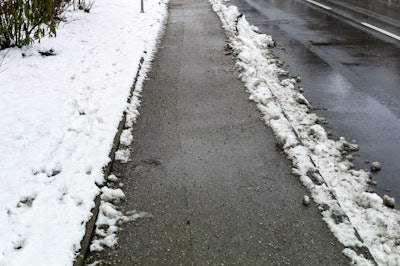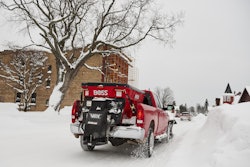
Want to download the entire Snow and Ice Removal Guide, including comprehensive specs on snow plows, from the editors at TLC?
Winter can be one of the more difficult seasons for landscaping companies, especially for those offering snow and ice removal services.
Solid and liquid products can be used in both anti-icing and deicing processes. The objective of anti-icing is to proactively inhibit snow accumulation from forming an ice bond with the pavement. Deicing is the reactive application of ice-control products to remove snow and ice.
According to Martin Tirado, CEO of the Snow and Ice Management Association (SIMA), the only differences in the processes are when they are performed and the application rates associated with the amount of removal products used.
“You usually use less when you pre-apply; sometimes when you post-apply, you’re trying to melt (the snow and ice) down to the pavement,” Tirado says. “So, sometimes it takes more, and you may have to reapply a couple of times depending on the weather conditions.”
Common removal agents
Tirado says there are three common products used in the anti-icing and deicing processes: bulk rock salt (sodium chloride), brine and calcium chloride.
Bulk rock salt can be used as a pre- and post-treatment option, as it will help prevent snow and ice from adhering to the pavement, as well as melt existing snow and ice. Tirado notes that bulk rock salt is the most commonly used in deicing.
Although landscapers are aware of the environmental downsides of using salt, Tirado says he hasn’t seen many landscapers shy away from using it, but instead, he has noticed landscapers exercising more educated distribution methods.
“People are still, obviously, using it; it’s the most widely available, affordable product,” he says. “What more contractors are doing is being smarter about it. They are using technology and better training to make sure they aren’t over-applying it.”

“My company uses both liquid and dry products to perform this task,” says Doug Knotts, owner of Knott’s Land Care in Amherst, New Hampshire. “However, the trend is to prevent bonding as much as possible via anti-icing techniques and to use plows with improved scraping ability. All deicing agents must become brine (liquid) in order to work, so technically, everyone uses brine.”
The third commonly used product is calcium chloride, which comes in a granular form. This agent is used sparingly across snow and ice removal companies, as it is much more expensive and is usually only used when temperatures drop to an extreme level.
Contractors also combine bulk rock salt and other agents to increase the effectiveness of the products, Tirado notes. In temperatures colder than 20-22 degrees Fahrenheit, rock salt will begin to lose its effectiveness, resulting in unsafe pavement conditions.
Tirado says combining the bulk rock salt with a liquid agent increases the melting ability of the agents, helps the liquids and salt to last longer on the area and enables the salt to stick to the pavement better, which reduces salt bounce. The salt could be pre-treated with the liquid before application, or the liquid can be added at the point of distribution.
“People who have pre-treated their bulk salt with liquids say it probably saves the amount you apply by 30 percent,” he says. “You use 30 percent less because it’s more effective. It creates that chemical reaction of lowering the freezing point of water, it sticks better and it lasts longer, meaning it helps melt at lower temperatures.”
For instance, Tirado says, a brine with a calcium chloride liquid will cause the bulk rock salt to better melt at lower temperatures.
Which is better?
According to Tirado, there is no particular process or product that has proved better than the others. Simply put, he says, it merely depends on the project at hand as to which removal process and agents will be more beneficial.
The analogy SIMA likes to use when asked which agents have the best performance is that snow and ice removal agents are like a toolbox.
“Depending on weather conditions, what the level of service is with the customer, etc., you can use these different things in your toolbox to help you achieve that level of service that your customer is looking for,” Tirado says.
Anti-icing (pretreatment) and deicing (post-treatment)
Before the application process begins, SIMA recommends taking a look at pavement temperature data from earlier days, as well as air temperature, to estimate a pavement temperature range. This data can be used to calculate the desired brine makeup and rate of application.
SIMA says liquids are typically distributed in either square feet per gallon, gallons per acre or gallons per lane mile. Generally speaking, a lane mile equates to a 1-mile long, 10-foot wide path, which has approximately 52,800 square feet, and an acre is usually rounded off to 43,000 square feet.
Varying conditions will affect the outcome, but typically when a pretreatment is applied, the first ¼ – to ½-inch of snow will melt, after which it will maintain a protective bottom slush barrier.
Pretreatment should take place one to three days prior to a storm, if possible. As long as rain is not part of the forecast and foot traffic in the area is limited, brine can be applied in advance.
According to Scott Zorno, CSP and owner of HighCountry Spray Systems in Conifer, Colorado, the deicing process is typically performed after plowing. The goal is to get the loosened snow and ice off the area with a blade then follow with adding deicing agents to take care of residual snow and ice.

In his experience, Zorno has noticed that liquids tend to produce deicing results noticeably faster than dry products because before a dry product can begin to melt ice, it must first become a liquid.
If a company wants to cut costs, Zorno recommends performing an anti-icing regiment, which can be done by using liquids or pre-treated salt.
It’s also wise for companies to consider how much sunlight the area will be exposed to, as well as the color of the pavement, Zorno notes. For pavements that are black or darker in color, more heat will be absorbed, which will allow the salt to create a decent melting rate even if the temperature is low. If working with lighter colored concrete, there will be significantly less heat absorbed, meaning the salt won’t be as capable of melting snow and ice on that surface.
ROI, benefits and downsides
If you find yourself wondering whether or not investing in anti-icing and deicing will yield a decent return on investment, take a look at some of the benefits associated with the practices.
In Zorno’s experience, it all comes down to the customer’s expectations for the project. If a company is working with customers who aren’t terribly picky and just want the snow gone, Zorno says they probably won’t be attracted to the idea of spending money on anti-icing or deicing regimens.
However, if your company caters to larger commercial clients, such as banks, hospitals, municipalities, etc., Zorno says it’s much easier to sell them on the idea of either a regular anti-icing or deicing regiment because it helps keep them out of potential injury-based lawsuits.
While Knotts believes the investment in snow and ice removal products yields benefits, he does recommend taking stock of the project in its entirety before deciding to apply anti-icing products.
“Anti-icing agents are the same as deicing agents; the ROI is in their use,” Knotts says. “Not all storms should have anti-icing performed. Sometimes anti-icing isn’t possible, as the staff is too tired and needs rest. Adding the extra hours prior to plowing start time can sometimes be an unnecessary risk.”
Knotts agrees that there are many benefits that accompany snow and ice removal processes, but he does caution against using them in every situation. For instance, he says if a weather report is incorrect, but you’ve already pretreated an area, chemicals were introduced to the environment unnecessarily.
Patrick Fuchs, municipal sales manager liquid applications with Buyers Products, says one of the biggest benefits he sees with using brine in the removal process is that it stays on the road.
“It does not run off the edges of the road as easily as straight salt will,” he says. “So, you have less salt running into ditches and eventually into rivers and streams.”
A downside, he says, is that public vehicles can potentially experience corrosion because they are driving in the salty liquid solution.
“Everyone wants to get to their destination safely and in a timely manner, so you have to deal with cleaning your vehicle undercarriage on a more consistent basis in the winter to reduce rust and corrosion,” he says.










